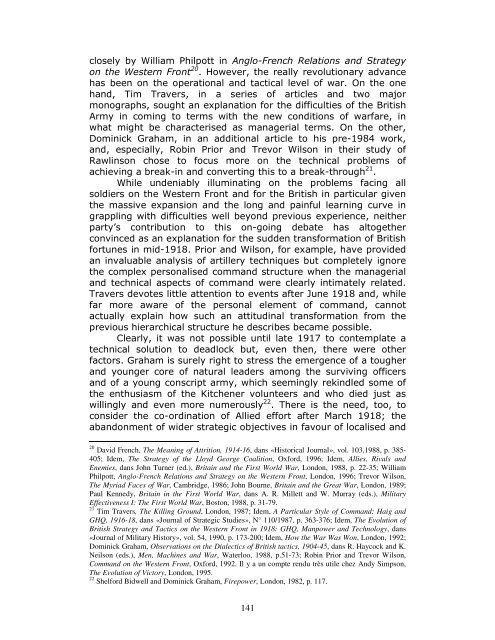Cet ouvrage a été publié avec le concours et le ... - Cour de France.fr
Cet ouvrage a été publié avec le concours et le ... - Cour de France.fr
Cet ouvrage a été publié avec le concours et le ... - Cour de France.fr
You also want an ePaper? Increase the reach of your titles
YUMPU automatically turns print PDFs into web optimized ePapers that Google loves.
closely by William Philpott in Anglo-French Relations and Strategy<br />
on the Western Front 20 . However, the really revolutionary advance<br />
has been on the operational and tactical <strong>le</strong>vel of war. On the one<br />
hand, Tim Travers, in a series of artic<strong>le</strong>s and two major<br />
monographs, sought an explanation for the difficulties of the British<br />
Army in coming to terms with the new conditions of warfare, in<br />
what might be characterised as managerial terms. On the other,<br />
Dominick Graham, in an additional artic<strong>le</strong> to his pre-1984 work,<br />
and, especially, Robin Prior and Trevor Wilson in their study of<br />
Rawlinson chose to focus more on the technical prob<strong>le</strong>ms of<br />
achieving a break-in and converting this to a break-through 21 .<br />
Whi<strong>le</strong> un<strong>de</strong>niably illuminating on the prob<strong>le</strong>ms facing all<br />
soldiers on the Western Front and for the British in particular given<br />
the massive expansion and the long and painful <strong>le</strong>arning curve in<br />
grappling with difficulties well beyond previous experience, neither<br />
party’s contribution to this on-going <strong>de</strong>bate has altog<strong>et</strong>her<br />
convinced as an explanation for the sud<strong>de</strong>n transformation of British<br />
fortunes in mid-1918. Prior and Wilson, for examp<strong>le</strong>, have provi<strong>de</strong>d<br />
an invaluab<strong>le</strong> analysis of artil<strong>le</strong>ry techniques but comp<strong>le</strong>tely ignore<br />
the comp<strong>le</strong>x personalised command structure when the managerial<br />
and technical aspects of command were c<strong>le</strong>arly intimately related.<br />
Travers <strong>de</strong>votes litt<strong>le</strong> attention to events after June 1918 and, whi<strong>le</strong><br />
far more aware of the personal e<strong>le</strong>ment of command, cannot<br />
actually explain how such an attitudinal transformation <strong>fr</strong>om the<br />
previous hierarchical structure he <strong>de</strong>scribes became possib<strong>le</strong>.<br />
C<strong>le</strong>arly, it was not possib<strong>le</strong> until late 1917 to contemplate a<br />
technical solution to <strong>de</strong>adlock but, even then, there were other<br />
factors. Graham is surely right to stress the emergence of a tougher<br />
and younger core of natural <strong>le</strong>a<strong>de</strong>rs among the surviving officers<br />
and of a young conscript army, which seemingly rekind<strong>le</strong>d some of<br />
the enthusiasm of the Kitchener volunteers and who died just as<br />
willingly and even more numerously 22 . There is the need, too, to<br />
consi<strong>de</strong>r the co-ordination of Allied effort after March 1918; the<br />
abandonment of wi<strong>de</strong>r strategic objectives in favour of localised and<br />
20 David French, The Meaning of Attrition, 1914-16, dans «Historical Journal», vol. 103,1988, p. 385-<br />
405; I<strong>de</strong>m, The Strategy of the Lloyd George Coalition, Oxford, 1996; I<strong>de</strong>m, Allies, Rivals and<br />
Enemies, dans John Turner (ed.), Britain and the First World War, London, 1988, p. 22-35; William<br />
Philpott, Anglo-French Relations and Strategy on the Western Front, London, 1996; Trevor Wilson,<br />
The Myriad Faces of War, Cambridge, 1986; John Bourne, Britain and the Great War, London, 1989;<br />
Paul Kennedy, Britain in the First World War, dans A. R. Mil<strong>le</strong>tt and W. Murray (eds.), Military<br />
Effectiveness I: The First World War, Boston, 1988, p. 31-79.<br />
21 Tim Travers, The Killing Ground, London, 1987; I<strong>de</strong>m, A Particular Sty<strong>le</strong> of Command: Haig and<br />
GHQ, 1916-18, dans «Journal of Strategic Studies», N° 110/1987, p. 363-376; I<strong>de</strong>m, The Evolution of<br />
British Strategy and Tactics on the Western Front in 1918: GHQ, Manpower and Technology, dans<br />
«Journal of Military History», vol. 54, 1990, p. 173-200; I<strong>de</strong>m, How the War Was Won, London, 1992;<br />
Dominick Graham, Observations on the Dia<strong>le</strong>ctics of British tactics, 1904-45, dans R. Haycock and K.<br />
Neilson (eds.), Men, Machines and War, Waterloo, 1988, p.51-73; Robin Prior and Trevor Wilson,<br />
Command on the Western Front, Oxford, 1992. Il y a un compte rendu très uti<strong>le</strong> chez Andy Simpson,<br />
The Evolution of Victory, London, 1995.<br />
22 Shelford Bidwell and Dominick Graham, Firepower, London, 1982, p. 117.<br />
141


